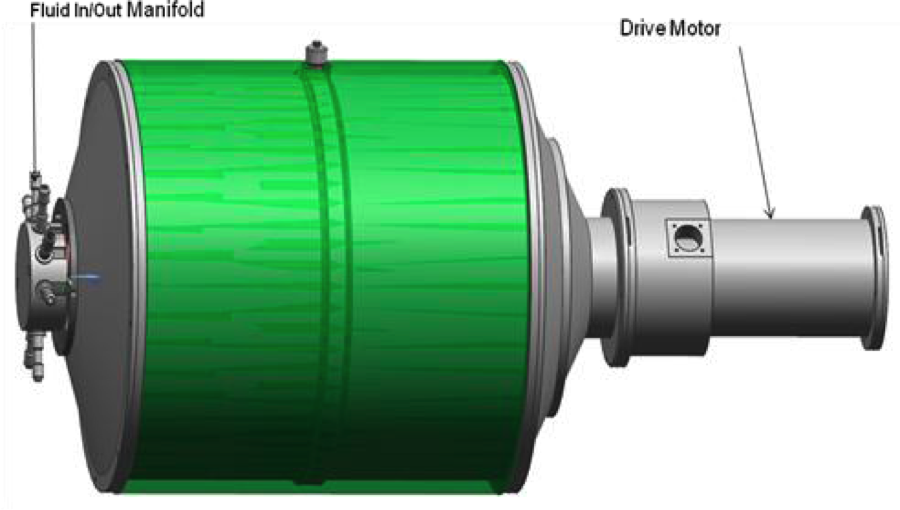JSC Team Improves R&M for Wastewater Recovery System That Will Support Mission to Mars
As NASA next-generation missions venture far beyond low Earth orbit, reliable and maintainable life support systems are critical to sustain Safety and Mission Assurance (SMA). A team at NASA’s Johnson Space Center (JSC) is working on a new version of a wastewater recovery system that will support human exploration to Mars.
The Cascade Distillation System (CDS) is a multi-stage vacuum rotary distiller system that uses centrifugal force to recover water in a microgravity environment. The new flight-like system is based on a ground-based prototype that JSC has been testing for the past decade.

Cascade Distiller Diagram
The JSC team is focused on making the new system, dubbed CDS 2.0, more reliable and maintainable than the system used on the International Space Station (ISS).
“Reliability and maintainability was one of the key aspects of the project,” said JSC Advanced Software Technologist Lui Wang. “Environmental support systems need to work continuously with minimum maintenance. It’s really one of those systems you want to turn on and forget about. That’s what we’re looking at, for it to be extremely automated and require very low maintenance.”
CDS 2.0 also needed to have a longer mission life span than its ISS predecessor in order to support a mission to Mars.
“We wanted to make sure we took into consideration quiescent time during an extensive Mars surface day, as well as on-orbit qualification break-in of the system prior to departure to Mars, so we gave [the system] a total 10-year life. Right now the on-orbit distiller is rated for about two years,” said JSC Systems Engineer Miriam Sargusingh.
The team is using a Model-Based Systems Engineering (MBSE) approach to create a common perspective of the system functions and interfaces for all of the stakeholders involved, and to introduce SMA requirements earlier in the process. MBSE provides a single source of information about the system and improves the effectiveness of Reliability and Maintainability (R&M) on the system and effectively deals with complexity.
“The model initially gets everyone to start speaking the same language,” said Wang. “We’re talking about an object that everyone can look at. It really helps with communication gaps. It puts everyone on the same page, and forces some standards early on in the process so SMA professionals can generate the products they need to do their analysis.”
Typically, each stakeholder in the process — designers, engineers, SMA analysts, etc. — would have their own set of tools and products. MBSE unifies the approach, which makes the process more efficient with less room for error.
“We model the behavior of the multiple system components and generate immediately a fault tree. We don’t have to go through paperwork and develop a fault tree by hand. And that’s extremely convenient, particularly because I don’t have to go to another tool,” said Sargusingh. “I don’t have to go through an SMA-specific tool to get the fault trees, I can pull them out of the same model that defines the rest of my system.”
The MBSE approach also allows SMA to be introduced earlier on in the process, instead of after the system has been designed or created.
“R&M analysis people are usually ‘M minus 1,’ they are always one step behind everyone else because they’re waiting for the system to be there before they comment or affect the system,” said Wang. “This common modeling language can be shared immediately and can produce analysis products almost immediately upfront.”
“We could have used a traditional R&M approach,” said R&M Program Manager Dr. John Evans, “but what happens is that R&M considerations fall behind the system design. Then when you try to implement changes to improve R&M, it is more difficult, costly and time-consuming. If you can integrate more considerations upfront, you can get it done in parallel with the design process. In that way we are able to do a better job with reliability and maintainability.”
Wang believes that someday all NASA systems will be designed using MBSE. “This addresses the overall systems integration issue. I believe this is the paradigm that we are all emerging to. People are saying, ‘I’m going to standardize a CAD [Computer-Aided Design] tool,’ but this standardizes the design.”
The Office of Safety and Mission Assurance supports the implementation of MBSE and Model-Based Mission Assurance in projects such as CDS 2.0, and sees the approach as having significant benefits such projects, said Evans.
The team currently is working towards a flight-like prototype in the JSC Advanced Water Recovery System Lab and projecting the ability to fly some key component technologies in the 2017 timeframe.